A mulberry tree is a must for your homestead or backyard. They are fast growing shade trees and provide food for your family and fodder for chickens, ducks, goats and other livestock. The mulberry tree leaves, bark and berries are all edible.

When we moved to our property we were so happy to find a large mulberry tree. The tree is actually in our neighbor’s yard but is huge and hangs over our fence. We’ve planted a few more around out property just in case something happens to our neighbor’s tree. One thing we’ve learned is that growing mulberry trees is pretty easy.
There are three main varieties of mulberries; red (morus rubra), white (morus alba) and black (m. nigra) – there is also an Texas mulberry tree (that has other common names). The red mulberry tree and the Texas mulberry tree are native to North America.

Identifying Mulberry Tree Varieties
According to Wildflower.org, “Both mulberries (red and Texas) show a variety of leaf shapes from ovate to lobed from tree to tree or on the same tree. The purple or red fruit (mulberries) of both the Texas mulberry and the red mulberry look very similar to the dewberry.” (A dewberry is a variety of wild blackberry that grows in much of Texas and other southern states.)
The white mulberry tree was first brought to the US from China to help encourage the silk industry because mulberry leaves are a favorite of the silk worm. The silk trade never really took off in the US but the white mulberry tree is hear to stay.
The black mulberry tree originated in Southwestern Asia and then spread to Europe and then the US. It’s the least common mulberry in the US.
As for growing and using mulberry trees there are only minor differences (other than the color) between the varieties. So, if, like me, you’ve inherited a mulberry tree and are not sure what variety it is, don’t worry too much about it.
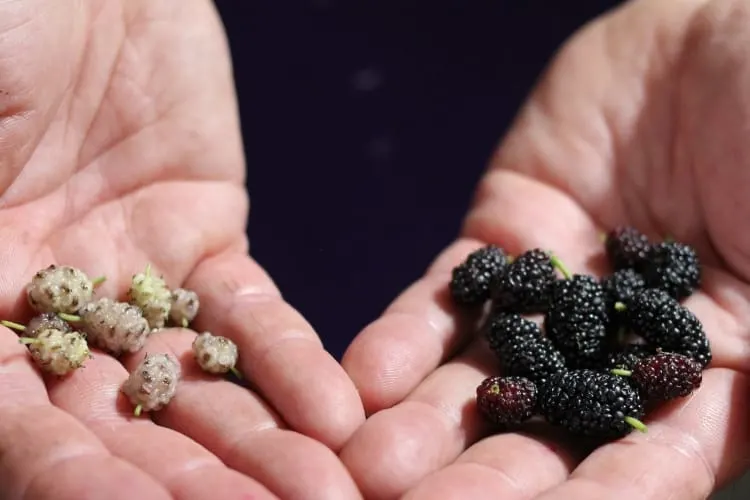
I believe we mainly have native red mulberry trees. We did find a white mulberry on our property recently that we didn’t plant – it produced white colored mulberries so I’m sure it’s a white mulberry tree. I’m sure it is a gift from a bird passing by.
The problem with trying to identify mulberry tree varieties by the fruit is that a white mulberry tree (m. alba) can produce white fruits, but it can also produce red and black colored mulberries.
To properly identify mulberry tree varieties you also need to look at and feel the leaves. Here’s a good resource for identifying red and white mulberry trees.
Mulberry trees can grow to over 30′ and 20′ across. So, make sure you have plenty of space for it. The good news is that many mulberry trees are self pollinating so you only need one tree.
The fruit is similar to a thin, long blackberry. I think the taste is similar to blackberries with mulberries being the sweeter of the two.
Because mulberry trees produce a lot of little messy fruits, most people recommend that you don’t plant it near driveways or porches. It would be great near a chicken yard, our chickens love hanging out under the mulberry tree and scratching around.
Mulberries are the one thing on our property that I don’t feel like I need to track and keep good notes on in my gardening notebook. They really are low maintenance and such a treat in early spring when they appear, so we just enjoy them for what they are and I don’t try to manage them for more production.

Planting or Propagating
When we bought our property there were several very small mulberry trees that were growing from seed on the property. Some got moved to areas where they can thrive and some got mowed down.
I now realize that those trees were probably in their first year, as mulberry trees grow fast. The tree above is now in its fourth year and has been producing mulberries for two years.
Of course, you can go to your local nursery and purchase a mulberry tree and bring it home and plant it. If you are buying a mulberry tree, be sure to check the variety, some mulberries are either self-pollinating or require separate male and female trees to produce fruit.The male flowers are about twice as long as the the female flowers.
But if you have a friend or neighbor who has a tree, you might be able to get one from them. Most people who have a mulberry tree also have “volunteers” pop up on their property.
You can also propagate a mulberry tree from cuttings but don’t take cutting while the tree has fruit on it. The cutting should be new growth, but old enough that it’s not green and pliable, it should be a soft wood cut.
Dip the cutting in a rooting hormone and then plant it in a pot. When the roots have grown and the small tree is growing you can plant it in the soil.
Mulberry trees need full sun, so be sure to plant it in a sunny location.
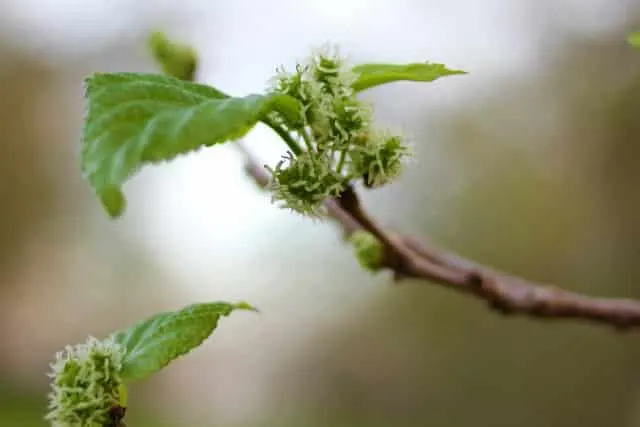
Caring for Mulberry Trees
Mulberry trees are super tolerant of all kinds of conditions, however, they do not like to have their roots wet all the time. So, plant them in well draining soil.
Once the tree is established you shouldn’t have to water it unless there is a drought. You also shouldn’t have to use any kind of fertilizer on it, however adding a bit of compost around it each spring will certainly be helpful.
Mulberry trees need very little pruning. If you decide to prune them, do it when the tree is dormant and don’t remove limbs that are over 2″ if possible.
They also don’t need frost protection and are cold hardy to well below freezing (some varieties are hardy to -25F) nor do they need a lot of chill hours and thrive where I am which is along the Texas Gulf Coast.
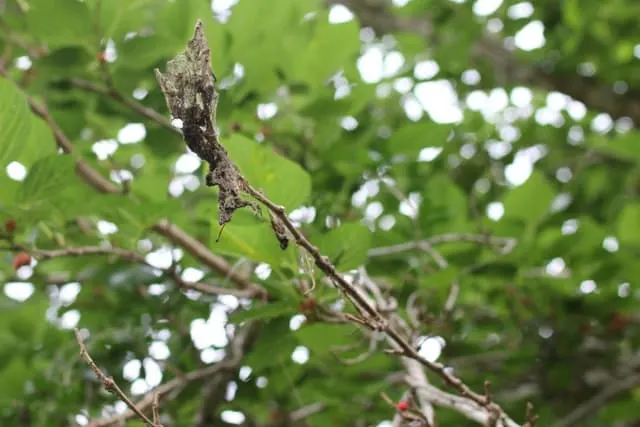
Pests and Problems
Mulberry trees don’t seem to have a lot of pest problems. Our tree gets web worms every spring, we just use an old broom to knock the webs off. If the infestation is really bad, we’ll cut the limb off and burn the whole thing. But the tree is very large and seems to bounce back year after year so we don’t use any chemicals on it.
You can also use bt on them which is used in many organic gardens to control worms. Bt will only treat the worms and not the beneficial bugs that are also living on the mulberry tree, however, if you have any butterfly or moth caterpillars on the tree, they will be treated too.
They can also attract white flies, mealybugs and scale. All of these are more of a nuisance than a huge problem for healthy mulberry trees. If you find that the tree is being damaged by these pests, you can do several things to lessen the damage.
For white flies and mealybugs, occasionally spraying the leaves with a blast of water can dislodge the them and reduce their population. Also, introducing ladybugs and lacewings will help control the white fly population.
I’ve even been known to haul the shop vac out to the garden and suck up the white flies – this is a fun job for children. Controlling ants around the mulberry tree will also help control the white flies and mealybugs, as the ants protect these pests.
For scale, cutting off and burning infested limbs and introducing ladybugs and parasitic wasps will help control them. You can also use a horticultural oil when the bugs are in their crawling stage – however, you’ll also treat the beneficial insects not just the pests.
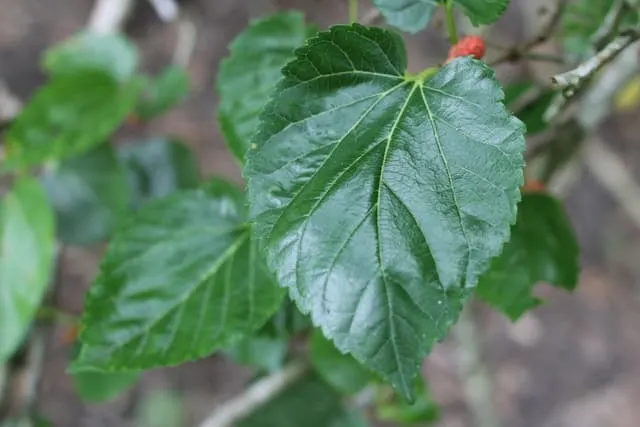
Harvesting and Using Mulberries
When the mulberries turn dark purple they are ready to harvest. Now, mulberries are much smaller than blackberries and it takes a lot of them to make a pie or preserve in a jam. So we mainly eat them fresh as a fun treat.
Also, the stems are super soft so we don’t feel a need to remove them, we just eat (or use) the whole mulberry with the stem attached.
However, we also have a container in the freezer that we add to each time we pick and we’ll use these berries in smoothies or combine them with other fruits for muffins.
You can also dehydrate them, just like you would blueberries, and add them to a tea for flavor.
Not only are the berries super nutritious but so are the leaves. Some people use the leaves as feed for their animals,which I think is a great idea, but they are also edible for people.
Our neighbor’s cow loves munching on the branches and leaves of our mulberry tree that hangs over their fence. Our hens wander over to the large mulberry tree to find shade and treats each day.
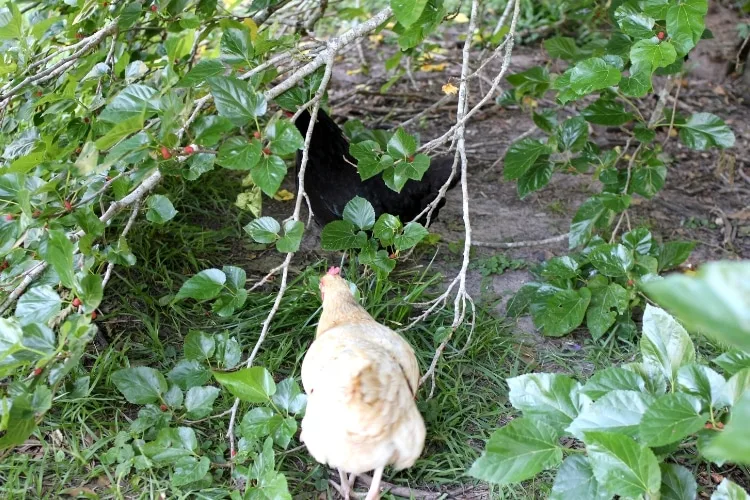
You can dehydrate the leaves and make a tea with them (we like to add some of the dehydrated fruit to the leaves for extra flavoring). To harvest mulberry tree leaves, choose mature leaves from healthy plants, wash them, and then dehydrate them in the dehydrator, oven or outside.
If you are interested in learning more about mulberries you might want to check out Herbal Roots zine Mulling Over Mulberries. It’s designed for children but I know some people who don’t have children who love them. I just bought this for Esther and I to go through, I think it will be fun.
The Herbal Academy has a fantastic monograph on mulberries in the Herbarium. If your’re not a member, you should consider becoming one. I’ve found it to be the most cost effective herbal training.
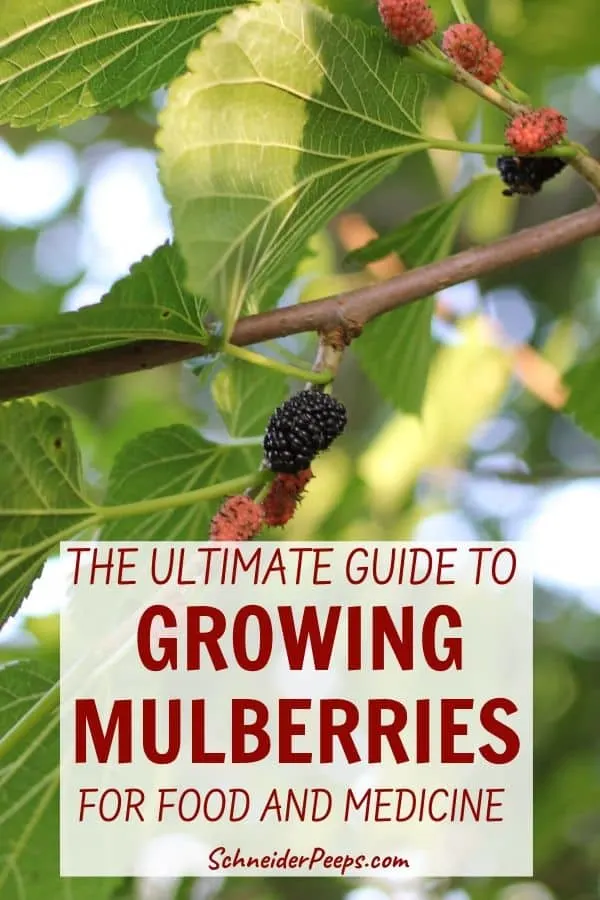
Do you grow mulberries? If so, feel free to leave an tips or recipes in the comments.


Ingrid
Sunday 9th of October 2022
Good morning, was wondering if you were able to give me alittle more information on the mulberry tree, we have 2 mulberry trees and love them, I didn’t know you can eat the leave and bark off these trees, can you eat them raw?? Or do they need to be blanched?? I did hear the white liquid from the leaves were poisonous?? I don’t have a dehydrater so not to sure how to dry them, I also just tried to bottle the mulberries, hope you are able to help me on these questions. Thank you ingrid
Angi Schneider
Friday 21st of October 2022
If you are going to eat the leaves (the bark is eaten by livestock, not people) pick young leaves and cook them first. There is a white sap that is latex and can be mildly irritating to some people. For tea, you can string the leaves and just dry them out by hanging them, they don't need to be blanched first.
raenellhill
Sunday 21st of August 2022
My 4 yr. old mulberry tree was covered with small berries in early spring ( the first year I have seen then). I was so excited as I thought this would be my first year for the berries. They all disappeared. What happened?
Angi Schneider
Friday 9th of September 2022
I don't know. It could be that the tree dropped the fruit due to some kind of stress. It could also be that the tree only put out male berries this first year.
E SMITH
Thursday 23rd of December 2021
Where is the best place to purchase mulberries? I purchased two last year from a certain nursery out 2 one persian tree died. The black SuperBerry is thriving, So out of 4 trees I ordered only the Black super berry survived.my conclusion is its where I got them and they were not cheap , with shipping 120.00 for 4 bare root trees at 1- 2 ft tall and for replacements I'm paying the 37.00 shipping fee, so where is the best place to get a pakistan or white mulberry? Thanks for any help
Angi Schneider
Sunday 26th of December 2021
Personally, I think the best place to get a mulberry tree is from a friend. They are easy to root from cuttings, so if you know someone who has them ask for cuttings. You can also propagate the one that survived that you planted. I've never actually purchased them, so I can't give you a referral to order them.
SADIA
Thursday 17th of June 2021
Hi, i have a white mulberry tree on the property i just purchased. Are the white mulberries or their leaves toxic to humans?
Angi Schneider
Sunday 20th of June 2021
No, they are not toxic. In fact they are quite healthy.
Nadia Kerr
Thursday 3rd of December 2020
We have a lovely mature mulberry tree in our backyard. It was gifted to my husband one Christmas as a small potted plant because he loves mulberries. We all love the mulberries in our house, freshly off the tree or make into jam, syrup and other yummy things. Any berries that are no good (such as been on the ground too long or slightly chewed by birds) get thrown into our worm farm. The worm juices eventually produced are recycled back onto the fruit and vegetable plants in our garden.
Any suggestions on how to keep possums and birds out of the tree? They steal or damage a lot of good fruit from it each season.
Angi Schneider
Monday 14th of December 2020
Other than netting the tree which could be quite hard if the tree is large, I don't really have any suggestions.